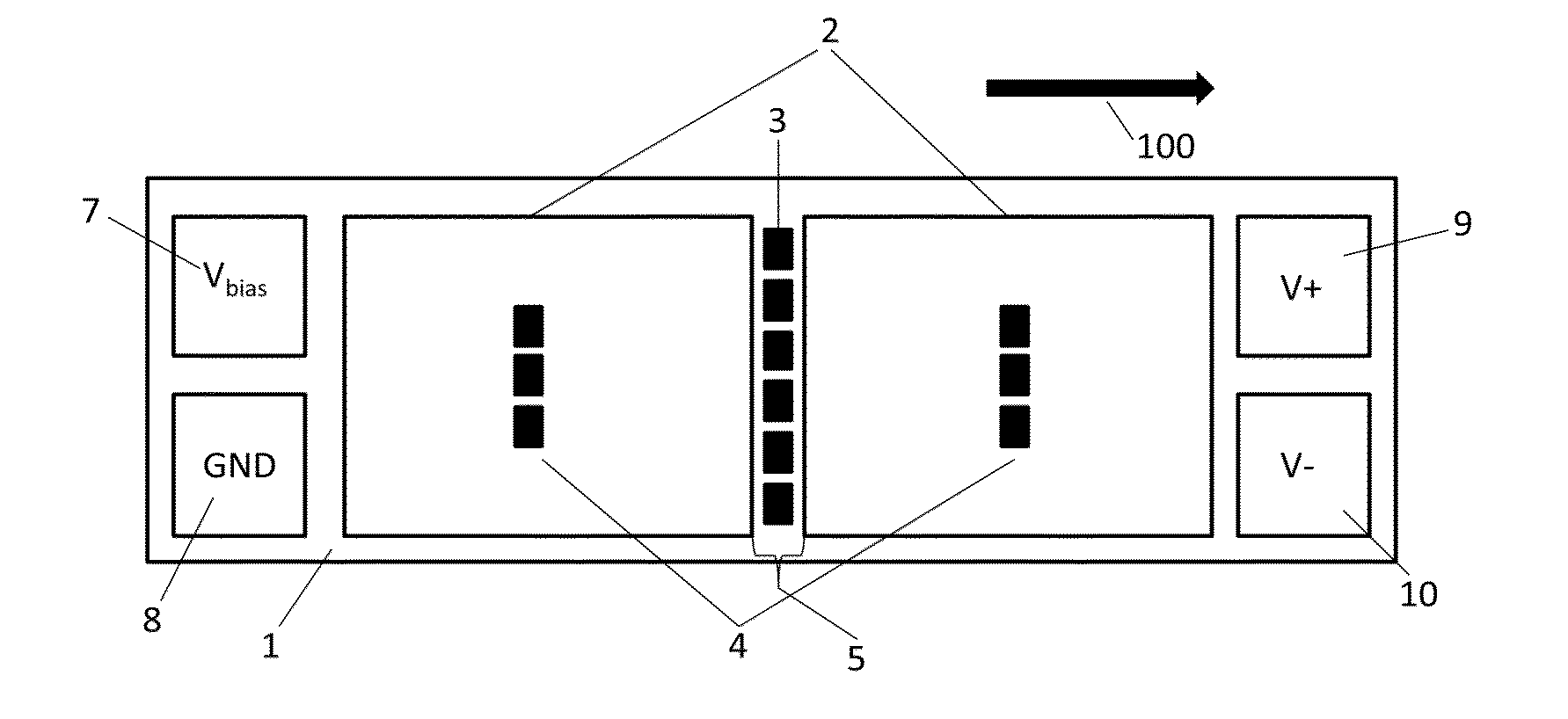Single-chip bridge-type magnetic field sensor
a magnetic field sensor and single-chip technology, applied in the field of magnetic field sensors, can solve the problems of low cost mass production of gmr or tmr sensors, two films are less consistent, and the process is complicated, so as to achieve good linearity, high sensitivity, and good linearity
- Summary
- Abstract
- Description
- Claims
- Application Information
AI Technical Summary
Benefits of technology
Problems solved by technology
Method used
Image
Examples
example 1
[0061]FIG. 2 shows a schematic diagram of a single-chip full-bridge magnetic field sensor of the present invention. The sensor comprises a substrate 1, a Wheatstone full-bridge deposited on the substrate 1, eight shielding structures 42 and four pads 7-10. The first bridge comprises reference arm R1 and sense arm S1, while the second bridge arm comprises reference arm R2 and sense arm S2; the reference arms R1 and R2 include three reference element strings each respectively, three in the first reference arm, and three in the second reference arm; the sense arms S1 and S2 include three sense element strings each respectively, three in the first sense arm, and three in the second sense arm. Each reference element string and each sensor element string are composed of one or more identical magnetoresistive sense elements that are electrically interconnected. As shown in FIG. 2, reference arm R1 and sense arm S1, reference arm R2 and sense arm S2 are composed of six identical magnetoresi...
example 2
[0069]FIG. 12 shows another implementation of the present invention. The sensor consists of a substrate 1, and onto the substrate a Wheatstone half-bridge is deposited, it has 6 shielding structures 42, and three wire bond pads 7-9. The Wheatstone half-bridge includes a reference arm R1 and a sense arm S1, each individually including 3 horizontal reference element strings 44 and 3 horizontal sense element strings 43, each reference element string 44 and each sense element string 43 includes a multitude of identical magnetoresistive sensing elements electrically interconnected, and there are 6 magnetoresistive elements per string shown in the figure. The sense element strings 43 and the reference element strings 44 are spaced vertically with respect to each other, and the spacing between the adjacent reference element strings 44 and sense element strings is L. The adjacent shielding structures 42 have a gap 45 between them, where the length and width of the gap 45 are different. Each...
example 3
[0072]The difference between this example and the second example is the use of a quasi Wheatstone bridge circuit. This single-chip magnetic field sensor bridge contains three wire bond pads, and of the three wire bond pads the first is used for grounding, while the second wire bond pad and the third wire bond pads are used for signal outputs. The Wheatstone quasi-bridge includes two identical current sources I1 and I2, a reference arm R1, and a sense arm S1. The current sources I1 and I2, the reference arm R1 and the sense arm S1 each have a first end and a second end. The first wire bond pad is electrically connected with the first end of reference arm R1, the first end of sense arm S1, and the first end of the two current sources I1 and I2. The second wire bond pad is electrically connected with the second end of reference are R1 and the second end of current source I2. The third wire bond pad is electrically connected with the second end of sense arm S1 and with the second end of...
PUM
 Login to View More
Login to View More Abstract
Description
Claims
Application Information
 Login to View More
Login to View More - R&D
- Intellectual Property
- Life Sciences
- Materials
- Tech Scout
- Unparalleled Data Quality
- Higher Quality Content
- 60% Fewer Hallucinations
Browse by: Latest US Patents, China's latest patents, Technical Efficacy Thesaurus, Application Domain, Technology Topic, Popular Technical Reports.
© 2025 PatSnap. All rights reserved.Legal|Privacy policy|Modern Slavery Act Transparency Statement|Sitemap|About US| Contact US: help@patsnap.com



